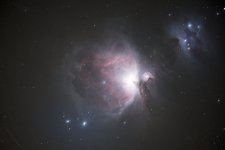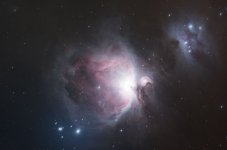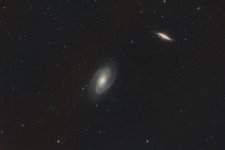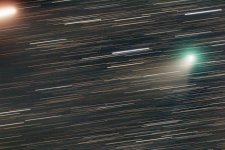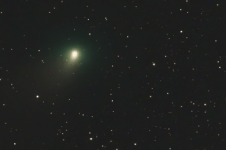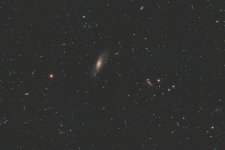You are using an out of date browser. It may not display this or other websites correctly.
You should upgrade or use an alternative browser.
You should upgrade or use an alternative browser.
Astronomy pictures thread
- Thread starter EricTheCat
- Start date
Welcome to the Precious Metals Bug Forums
Welcome to the PMBug forums - a watering hole for folks interested in gold, silver, precious metals, sound money, investing, market and economic news, central bank monetary policies, politics and more.
Why not register an account and join the discussions? When you register an account and log in, you may enjoy additional benefits including no Google ads, market data/charts, access to trade/barter with the community and much more. Registering an account is free - you have nothing to lose!
Fantastic. Glad it all worked well for you. Also I love the background galaxies in that field.
- Messages
- 505
- Reaction score
- 743
- Points
- 268
Someone on CN's asked me to share how the sausage was made. I will post it here also.
I used pixInsight to post-process, the shots were taken with a MONO camera and filter wheel.
100-60 second shots, cycling through R-G-B...R-G-B. A OSC would be simpler, I ordered one for the next comet.
Two images were produced, one aligned on the stars and another made with pixInsight's CometAlignment process, which aligned on the comet.
Before combining the images that were comet aligned, the stars were removed with Russell Croman's starXterminator (PixInsight add-on).
Once these two images were made, then followed this man's video steps (roughly).
https://www.youtube....h?v=SNdt-d__RFg
Simple right? LOL
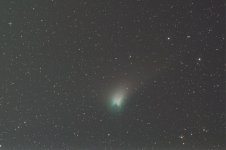
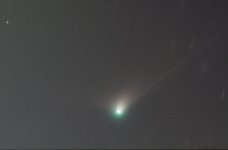
I used pixInsight to post-process, the shots were taken with a MONO camera and filter wheel.
100-60 second shots, cycling through R-G-B...R-G-B. A OSC would be simpler, I ordered one for the next comet.
Two images were produced, one aligned on the stars and another made with pixInsight's CometAlignment process, which aligned on the comet.
Before combining the images that were comet aligned, the stars were removed with Russell Croman's starXterminator (PixInsight add-on).
Once these two images were made, then followed this man's video steps (roughly).
https://www.youtube....h?v=SNdt-d__RFg
Simple right? LOL


COMETS
Forget the hype and go outside to enjoy the real thing — a relatively bright comet you can see in binoculars from a dark sky.
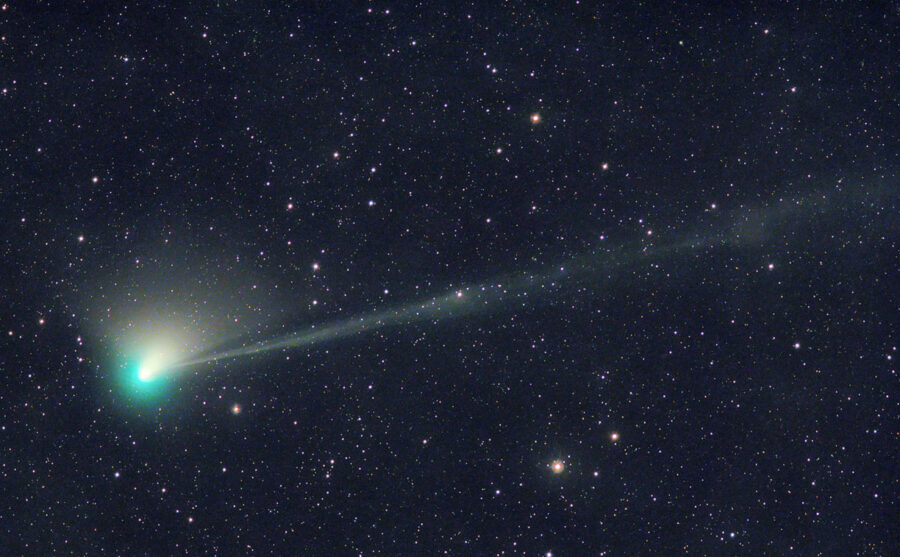 Comet ZTF (C/2022 E3) displays a bright, fan-shaped dust tail and an ion tail more than 4° long on January 12, 2023. Two cameras were used for the composite image — an 11-inch RASA to capture a detailed black-and-white image, and a DSLR with a 280-mm focal length lens for the color shot.
Comet ZTF (C/2022 E3) displays a bright, fan-shaped dust tail and an ion tail more than 4° long on January 12, 2023. Two cameras were used for the composite image — an 11-inch RASA to capture a detailed black-and-white image, and a DSLR with a 280-mm focal length lens for the color shot.
Michael Jaeger
Dazzling green comet! First appearance in 50,000 years! Watch it streak across the sky! Based on recent headlines you’d think Comet ZTF (C/2022 E3) was the greatest astronomical event of modern times. While it’s not all that, this Oort Cloud refugee is already visible in binoculars and a pretty sight in modest telescopes. Observers with dark, moonless skies may even spot the comet with the naked eye (dimly) as it sails between the the Big and Little Dippers later this month. Thanks to clouds and moonlight I last saw it in late December at 8th magnitude in Corona Borealis.
Current visual magnitude estimates put Comet ZTF at between magnitude 6.5 and 7.0. Expect it to peak around magnitude 5.5 at the end of January into early February. Not to throw shade, but Jose Pablo Navarro, amateur astronomer and administrator of the Facebook group Comet Asteroid Meteor Watch, examined 2,509 visual and CCD observations of the comet from the Minor Planet Center database. His analysis indicates a recent slowdown in the comet's rate of brightening, with a peak brightness closer to 6.0 magnitude. Time will tell.
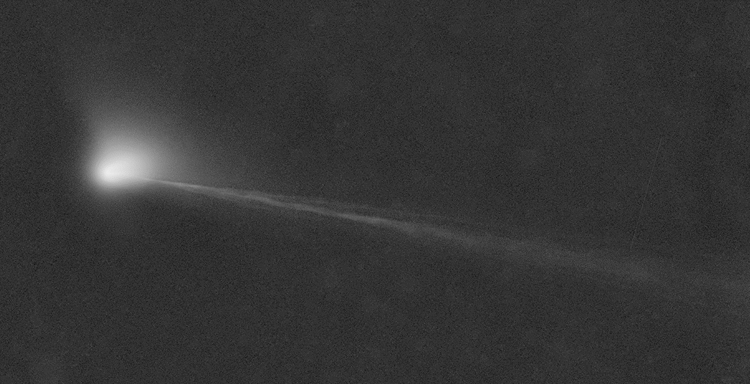 Gas leaving the comet streams down its ion tail in this 12-image animation made on January 14, 2023, from 2:20 to 3:30 UT.
Gas leaving the comet streams down its ion tail in this 12-image animation made on January 14, 2023, from 2:20 to 3:30 UT.
Michael Jaeger
Photographs show a striking blue-green coma, a feature often seen in comets that journey into the inner solar system. Solar ultraviolet (UV) light breaks down large organic molecules boiling off the nucleus into simpler compounds, including green-glowing diatomic carbon (C2). Within a couple of days, that same energetic light destroys the molecule before it has time to leave the coma, preventing it from traveling into the comet’s tail and tinging it green. Sometimes the delightful Caribbean hue is subtly visible in binoculars, but normally a 6-inch or larger telescope is required.
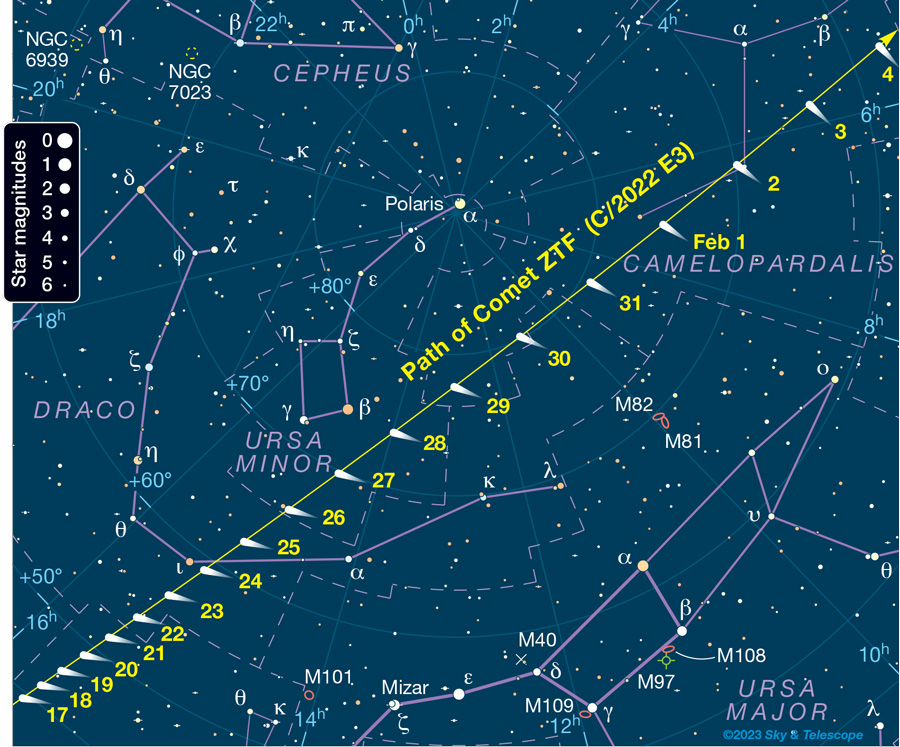 Use this finder chart to spot Comet ZTF (C/2022 E3) as it marches across the northern sky. Comet positions are shown for 0h UT on the indicated date. Click here for a high-resolution map.
Use this finder chart to spot Comet ZTF (C/2022 E3) as it marches across the northern sky. Comet positions are shown for 0h UT on the indicated date. Click here for a high-resolution map.
Sky & Telescope
Comet ZTF (C/2022 E3) is named for the Zwicky Transient Facility, a public-private partnership based at Caltech’s Palomar Observatory in California. Every two nights, a wide-field CCD camera attached to the 48-inch Samuel Oschin Telescope scans the entire northern sky in search of anything that blinks or moves. Among its quarry are near-Earth asteroids, thousands of supernovae (more than 6,600 classified to date), and numerous comets.
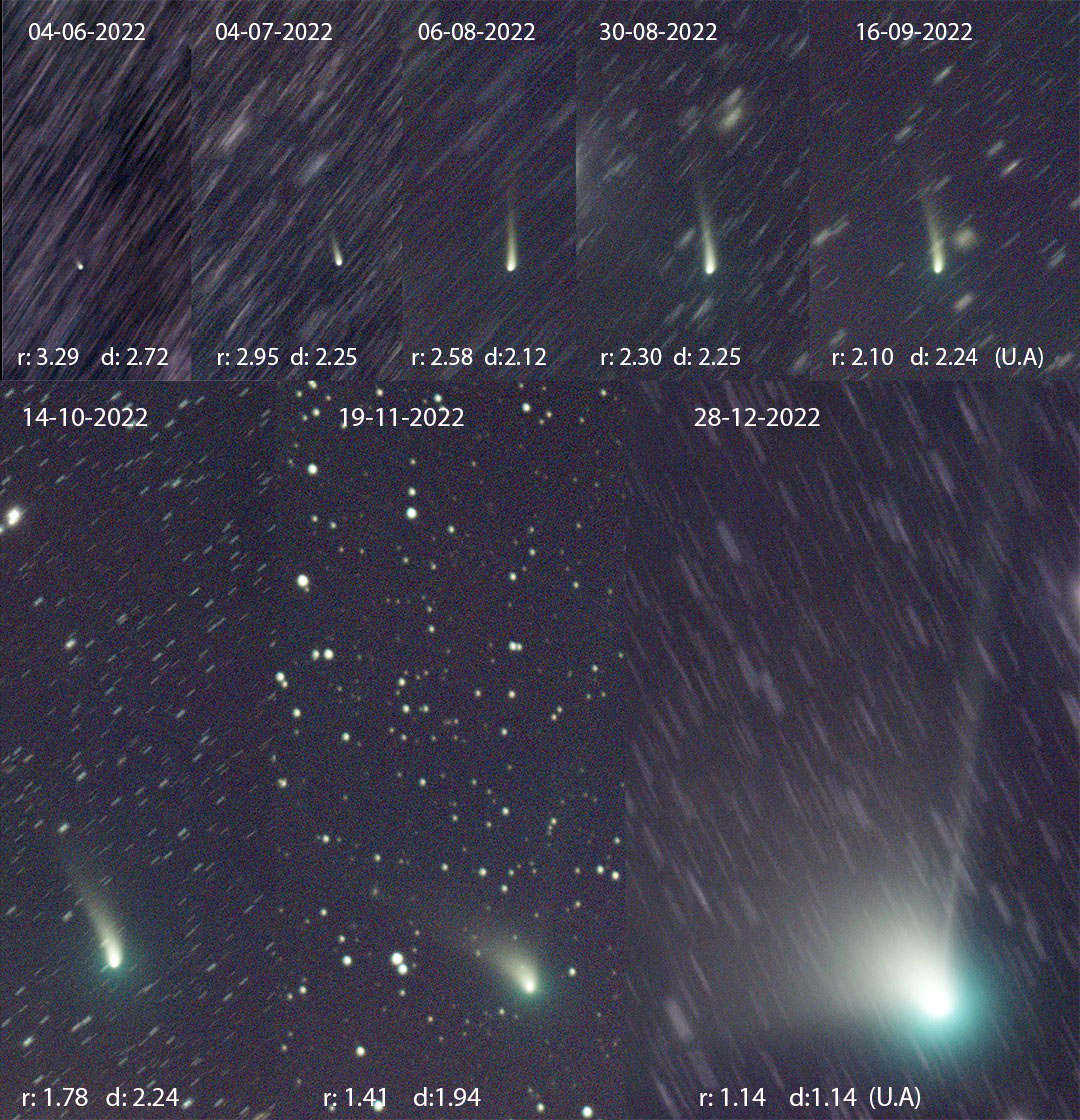 This image sequence shows the comet's evolution from a 14th-magnitude blip on June 4, 2022, (upper left) to a binocular-bright object with two tails on December 28th. The same focal length, camera, and similar exposure time were used for each photo except November 19th due to the comet's low altitude. Its distance from the Sun (r) and Earth (d) in astronomical units (a.u.) are also shown.
This image sequence shows the comet's evolution from a 14th-magnitude blip on June 4, 2022, (upper left) to a binocular-bright object with two tails on December 28th. The same focal length, camera, and similar exposure time were used for each photo except November 19th due to the comet's low altitude. Its distance from the Sun (r) and Earth (d) in astronomical units (a.u.) are also shown.
Continued in next post
CIRCUMPOLAR COMET ZTF (C/2022 E3) IS HERE!
BY: BOB KING JANUARY 16, 2023Forget the hype and go outside to enjoy the real thing — a relatively bright comet you can see in binoculars from a dark sky.
 Comet ZTF (C/2022 E3) displays a bright, fan-shaped dust tail and an ion tail more than 4° long on January 12, 2023. Two cameras were used for the composite image — an 11-inch RASA to capture a detailed black-and-white image, and a DSLR with a 280-mm focal length lens for the color shot.
Comet ZTF (C/2022 E3) displays a bright, fan-shaped dust tail and an ion tail more than 4° long on January 12, 2023. Two cameras were used for the composite image — an 11-inch RASA to capture a detailed black-and-white image, and a DSLR with a 280-mm focal length lens for the color shot.Michael Jaeger
Dazzling green comet! First appearance in 50,000 years! Watch it streak across the sky! Based on recent headlines you’d think Comet ZTF (C/2022 E3) was the greatest astronomical event of modern times. While it’s not all that, this Oort Cloud refugee is already visible in binoculars and a pretty sight in modest telescopes. Observers with dark, moonless skies may even spot the comet with the naked eye (dimly) as it sails between the the Big and Little Dippers later this month. Thanks to clouds and moonlight I last saw it in late December at 8th magnitude in Corona Borealis.
Current visual magnitude estimates put Comet ZTF at between magnitude 6.5 and 7.0. Expect it to peak around magnitude 5.5 at the end of January into early February. Not to throw shade, but Jose Pablo Navarro, amateur astronomer and administrator of the Facebook group Comet Asteroid Meteor Watch, examined 2,509 visual and CCD observations of the comet from the Minor Planet Center database. His analysis indicates a recent slowdown in the comet's rate of brightening, with a peak brightness closer to 6.0 magnitude. Time will tell.
 Gas leaving the comet streams down its ion tail in this 12-image animation made on January 14, 2023, from 2:20 to 3:30 UT.
Gas leaving the comet streams down its ion tail in this 12-image animation made on January 14, 2023, from 2:20 to 3:30 UT.Michael Jaeger
Photographs show a striking blue-green coma, a feature often seen in comets that journey into the inner solar system. Solar ultraviolet (UV) light breaks down large organic molecules boiling off the nucleus into simpler compounds, including green-glowing diatomic carbon (C2). Within a couple of days, that same energetic light destroys the molecule before it has time to leave the coma, preventing it from traveling into the comet’s tail and tinging it green. Sometimes the delightful Caribbean hue is subtly visible in binoculars, but normally a 6-inch or larger telescope is required.

Sky & Telescope
Comet ZTF (C/2022 E3) is named for the Zwicky Transient Facility, a public-private partnership based at Caltech’s Palomar Observatory in California. Every two nights, a wide-field CCD camera attached to the 48-inch Samuel Oschin Telescope scans the entire northern sky in search of anything that blinks or moves. Among its quarry are near-Earth asteroids, thousands of supernovae (more than 6,600 classified to date), and numerous comets.
 This image sequence shows the comet's evolution from a 14th-magnitude blip on June 4, 2022, (upper left) to a binocular-bright object with two tails on December 28th. The same focal length, camera, and similar exposure time were used for each photo except November 19th due to the comet's low altitude. Its distance from the Sun (r) and Earth (d) in astronomical units (a.u.) are also shown.
This image sequence shows the comet's evolution from a 14th-magnitude blip on June 4, 2022, (upper left) to a binocular-bright object with two tails on December 28th. The same focal length, camera, and similar exposure time were used for each photo except November 19th due to the comet's low altitude. Its distance from the Sun (r) and Earth (d) in astronomical units (a.u.) are also shown.Continued in next post
Dídac Mesa Romeu
C/2022 E3 was discovered on March 2, 2022, and initially reported as an asteroid candidate. One night later, Japanese observer Hirohisa Sato’s photographs of the object revealed a small coma, changing its status to a comet. More observations by additional observers confirmed Sato’s report. At the time, the 17th-magnitude speck was nearly 5 astronomical units from Earth, nearly identical to Jupiter’s average distance from the Sun.
On January 16–17, you’ll find our fuzzy friend in northeastern Boötes headed northwest at around 1.5° per day. Closest approach to Earth occurs on February 1st, when the comet will whiz past at 42 million kilometers (26 million miles). Perihelion (closest approach to the Sun) occurred on January 12th at 166 million kilometers (103 million miles).
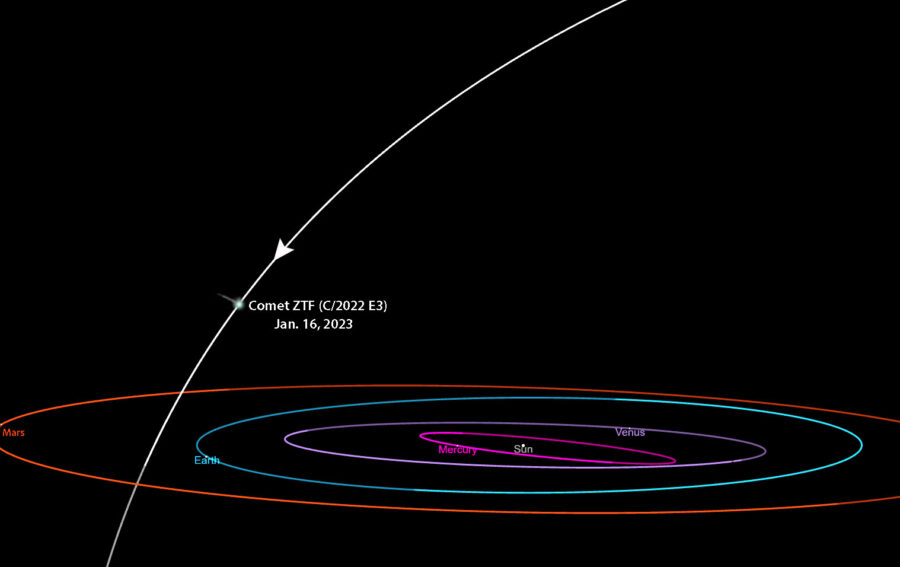 With an inclination of 109°, Comet ZTF E3's orbit is steeply tilted to the plane of the planets. It's headed southward in January and will cross the ecliptic plane on February 12th.
With an inclination of 109°, Comet ZTF E3's orbit is steeply tilted to the plane of the planets. It's headed southward in January and will cross the ecliptic plane on February 12th.
NASA HORIZONS
As Comet ZTF E3 closes in on our planet in the coming weeks, its apparent motion across the northern sky and altitude increase quickly. The comet becomes a circumpolar object for the northern states and Canada around January 17th and for the rest of the continental U.S. on January 25th. Come month’s end, Comet ZTF will be trucking along at the rate of 6.5° a day! That’s better than ¼° per hour, making its motion relative to the background stars obvious through a telescope after just a few minutes. Even 10× binoculars will reveal movement in an hour or two.
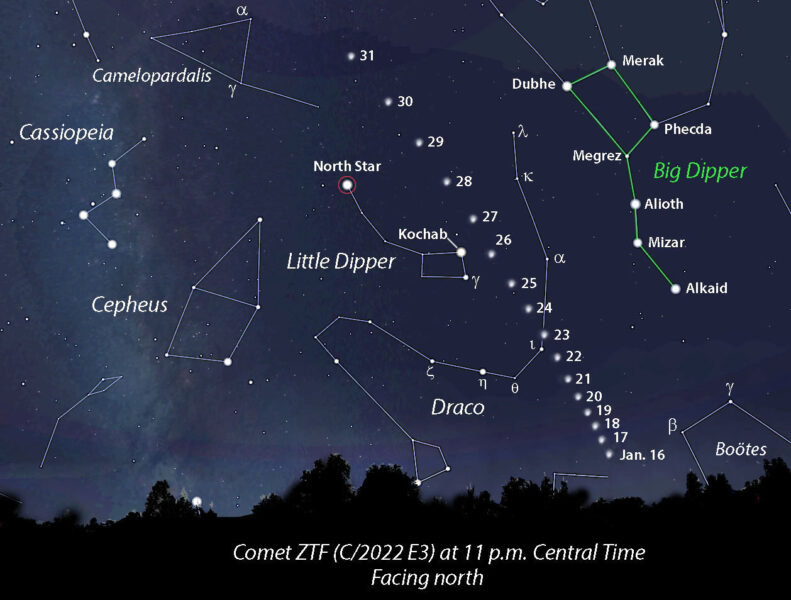 The comet speedily mounts the northern sky this month as seen from latitude 45° north. Positions are shown for 11 p.m. CST. Remember to use binoculars as the comet will likely appear rather faint from light-polluted locations.
The comet speedily mounts the northern sky this month as seen from latitude 45° north. Positions are shown for 11 p.m. CST. Remember to use binoculars as the comet will likely appear rather faint from light-polluted locations.
Stellarium with additions by Bob King
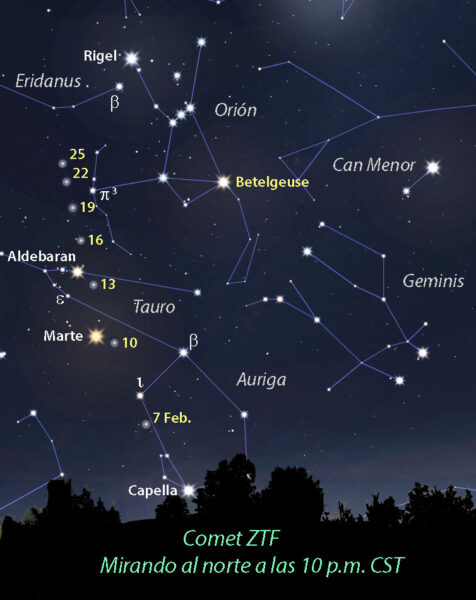 In this Spanish language version, the comet's position is shown every 3 nights for latitude 35° south at 10 p.m. CST. Stars are plotted to ~6.0 magnitude. From mid-southern latitudes, Comet ZTF will first become visible low in the northern sky in Auriga in early February. The position of Mars (Marte) is shown for Feb. 7.
In this Spanish language version, the comet's position is shown every 3 nights for latitude 35° south at 10 p.m. CST. Stars are plotted to ~6.0 magnitude. From mid-southern latitudes, Comet ZTF will first become visible low in the northern sky in Auriga in early February. The position of Mars (Marte) is shown for Feb. 7.
Stellarium with additions by Bob King
From latitude 40° north the comet stands 10° high in the northeastern sky on the night of January 16–17 at local midnight. That improves to 21° five nights later on January 21st. During much of January, observers in the northern U.S. will see the comet higher up earlier in the night compared to those in the southern part of the country, where the best views will be after 2 a.m. local time. Viewing becomes more equitable across the U.S. by late January when the object will be circumpolar for everyone. The table below addresses Comet ZTF’s continually changing circumstances as it climbs higher and higher while playing tag with the Moon.
Here are the best times for viewing the comet through late February from latitude 40° north. "Best" is defined as minimal interference from moonlight with the comet at least 25° high. Southern observers will see the comet a little lower; northern ones higher. Bolded dates are nights with little to modest moonlight and convenient evening viewing hours.
First-quarter phase occurs on January 28th, when the Moon will set around 12:30 a.m. (on January 29th). A half-moon isn’t much of a comet-killer especially when it shines at the opposite end of the sky. However, by month’s end, the waxing gibbous Moon in Taurus and then Gemini will diminish the comet’s appearance if you plan to observe it before midnight. Fortunately, the Moon sets in the wee hours through February 2nd, leaving dark-sky windows to observe and photograph the bearded visitor at its closest and brightest.
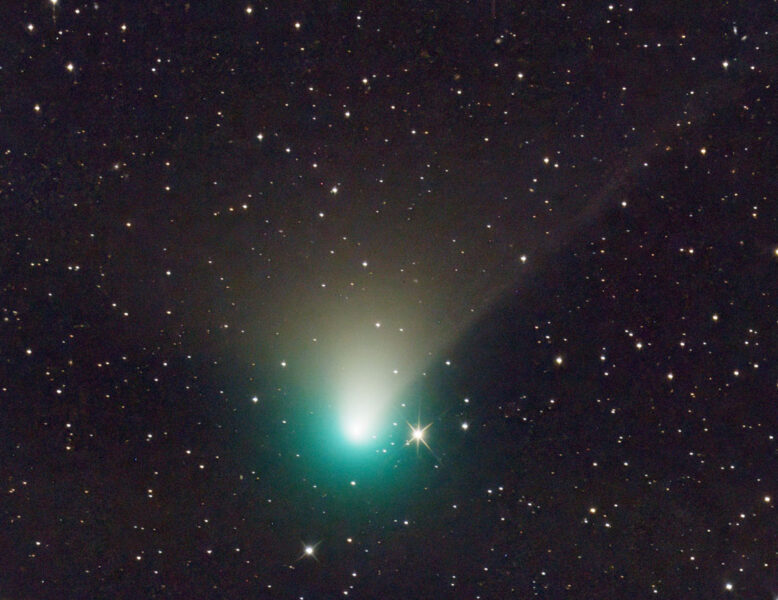 The comet's short but prominent dust tail — seen here on January 3, 2023 — is fan-shaped and easily seen in a telescope. It currently points to the northwest. The much fainter ion tail (right) extends to the north-northeast.
The comet's short but prominent dust tail — seen here on January 3, 2023 — is fan-shaped and easily seen in a telescope. It currently points to the northwest. The much fainter ion tail (right) extends to the north-northeast.
Juanjo Gonzalez
By early February the comet is firmly ensconced in the evening sky. It slides about 1.5° southwest of Capella on the evening of February 5th, the night of full Moon. The following evening it brushes Zeta (ζ) Aurigae in the Kids asterism. While the compact nuclear region will miss the star by ~10′, the fluffy coma may temporarily engulf it. Mars gets a visit on the night of February 10–11 when the comet cruises about 1.5° northeast of the planet for observers in the eastern half of the Americas. West Coast viewers will see them just 1° apart. The two bodies, one golden-orange, the other green and turquoise, should make a fine color contrast in time-exposure photos. Come Valentine’s Day (February 14th), Comet ZTF will have faded to about magnitude 7.0 and glow in a moonless sky around 1.5° east of Aldebaran in Taurus.
Then it’s back home for this interloper. Although its inbound journey took some 50,000 years, the return voyage to the Oort Cloud is expected to be in the millions. Don’t forget to wave “goodbye!” You can stay abreast of the comet’s magnitude, coma diameter, and more at the Comet Observation Database (COBS). Click on the Recent Observations link, then search for C/2022 E3. Another excellent source is Weekly Information about Bright Comets. Happy hunting!

January 16, 2023 at 3:43 pm
Finally, the real story! Thank you thank you thank you! I have been trying to battle the mainstream media (and many "science") hyped posts but it is a losing battle! One of the worst things is that I have not seen another article that talks about the moon being a problem, and it is a big problem with this comet for anyone who wants to see it naked eye. The one thing I would like to see is a photo showing what it looks like in say an 8 inch scope.
C/2022 E3 was discovered on March 2, 2022, and initially reported as an asteroid candidate. One night later, Japanese observer Hirohisa Sato’s photographs of the object revealed a small coma, changing its status to a comet. More observations by additional observers confirmed Sato’s report. At the time, the 17th-magnitude speck was nearly 5 astronomical units from Earth, nearly identical to Jupiter’s average distance from the Sun.
On January 16–17, you’ll find our fuzzy friend in northeastern Boötes headed northwest at around 1.5° per day. Closest approach to Earth occurs on February 1st, when the comet will whiz past at 42 million kilometers (26 million miles). Perihelion (closest approach to the Sun) occurred on January 12th at 166 million kilometers (103 million miles).

NASA HORIZONS
As Comet ZTF E3 closes in on our planet in the coming weeks, its apparent motion across the northern sky and altitude increase quickly. The comet becomes a circumpolar object for the northern states and Canada around January 17th and for the rest of the continental U.S. on January 25th. Come month’s end, Comet ZTF will be trucking along at the rate of 6.5° a day! That’s better than ¼° per hour, making its motion relative to the background stars obvious through a telescope after just a few minutes. Even 10× binoculars will reveal movement in an hour or two.
 The comet speedily mounts the northern sky this month as seen from latitude 45° north. Positions are shown for 11 p.m. CST. Remember to use binoculars as the comet will likely appear rather faint from light-polluted locations.
The comet speedily mounts the northern sky this month as seen from latitude 45° north. Positions are shown for 11 p.m. CST. Remember to use binoculars as the comet will likely appear rather faint from light-polluted locations.Stellarium with additions by Bob King
 In this Spanish language version, the comet's position is shown every 3 nights for latitude 35° south at 10 p.m. CST. Stars are plotted to ~6.0 magnitude. From mid-southern latitudes, Comet ZTF will first become visible low in the northern sky in Auriga in early February. The position of Mars (Marte) is shown for Feb. 7.
In this Spanish language version, the comet's position is shown every 3 nights for latitude 35° south at 10 p.m. CST. Stars are plotted to ~6.0 magnitude. From mid-southern latitudes, Comet ZTF will first become visible low in the northern sky in Auriga in early February. The position of Mars (Marte) is shown for Feb. 7.Stellarium with additions by Bob King
From latitude 40° north the comet stands 10° high in the northeastern sky on the night of January 16–17 at local midnight. That improves to 21° five nights later on January 21st. During much of January, observers in the northern U.S. will see the comet higher up earlier in the night compared to those in the southern part of the country, where the best views will be after 2 a.m. local time. Viewing becomes more equitable across the U.S. by late January when the object will be circumpolar for everyone. The table below addresses Comet ZTF’s continually changing circumstances as it climbs higher and higher while playing tag with the Moon.
| Dates | Comet 25° or higher, minimal Moon | Moon phase |
| Jan. 16–24 | Midnight till dawn | Waning crescent to waxing crescent |
| Jan. 24 | 11 p.m. till dawn | Waxing crescent |
| Jan. 25 | 10 p.m. till dawn | " " |
| Jan. 26 | 9 p.m. till dawn | " " |
| Jan. 27–28 | 7 p.m. till dawn | " " |
| Jan. 29–Feb. 2 | Early morning hours after moonset | First quarter to waxing gibbous |
| Feb. 3–5 | Moon interferes all night | Waxing gibbous to full Moon |
| Feb. 6–22 | Moonless window opens again — evening hours | Waning gibbous to waxing crescent |
First-quarter phase occurs on January 28th, when the Moon will set around 12:30 a.m. (on January 29th). A half-moon isn’t much of a comet-killer especially when it shines at the opposite end of the sky. However, by month’s end, the waxing gibbous Moon in Taurus and then Gemini will diminish the comet’s appearance if you plan to observe it before midnight. Fortunately, the Moon sets in the wee hours through February 2nd, leaving dark-sky windows to observe and photograph the bearded visitor at its closest and brightest.
 The comet's short but prominent dust tail — seen here on January 3, 2023 — is fan-shaped and easily seen in a telescope. It currently points to the northwest. The much fainter ion tail (right) extends to the north-northeast.
The comet's short but prominent dust tail — seen here on January 3, 2023 — is fan-shaped and easily seen in a telescope. It currently points to the northwest. The much fainter ion tail (right) extends to the north-northeast.Juanjo Gonzalez
By early February the comet is firmly ensconced in the evening sky. It slides about 1.5° southwest of Capella on the evening of February 5th, the night of full Moon. The following evening it brushes Zeta (ζ) Aurigae in the Kids asterism. While the compact nuclear region will miss the star by ~10′, the fluffy coma may temporarily engulf it. Mars gets a visit on the night of February 10–11 when the comet cruises about 1.5° northeast of the planet for observers in the eastern half of the Americas. West Coast viewers will see them just 1° apart. The two bodies, one golden-orange, the other green and turquoise, should make a fine color contrast in time-exposure photos. Come Valentine’s Day (February 14th), Comet ZTF will have faded to about magnitude 7.0 and glow in a moonless sky around 1.5° east of Aldebaran in Taurus.
Then it’s back home for this interloper. Although its inbound journey took some 50,000 years, the return voyage to the Oort Cloud is expected to be in the millions. Don’t forget to wave “goodbye!” You can stay abreast of the comet’s magnitude, coma diameter, and more at the Comet Observation Database (COBS). Click on the Recent Observations link, then search for C/2022 E3. Another excellent source is Weekly Information about Bright Comets. Happy hunting!

COMMENTS
Tom HoffelderJanuary 16, 2023 at 3:43 pm
Finally, the real story! Thank you thank you thank you! I have been trying to battle the mainstream media (and many "science") hyped posts but it is a losing battle! One of the worst things is that I have not seen another article that talks about the moon being a problem, and it is a big problem with this comet for anyone who wants to see it naked eye. The one thing I would like to see is a photo showing what it looks like in say an 8 inch scope.
"Observers with dark, moonless skies may even spot the comet with the naked eye (dimly) as it sails between the the Big and Little Dippers later this month"Dídac Mesa Romeu
C/2022 E3 was discovered on March 2, 2022, and initially reported as an asteroid candidate. One night later, Japanese observer Hirohisa Sato’s photographs of the object revealed a small coma, changing its status to a comet. More observations by additional observers confirmed Sato’s report. At the time, the 17th-magnitude speck was nearly 5 astronomical units from Earth, nearly identical to Jupiter’s average distance from the Sun.
On January 16–17, you’ll find our fuzzy friend in northeastern Boötes headed northwest at around 1.5° per day. Closest approach to Earth occurs on February 1st, when the comet will whiz past at 42 million kilometers (26 million miles). Perihelion (closest approach to the Sun) occurred on January 12th at 166 million kilometers (103 million miles).
With an inclination of 109°, Comet ZTF E3's orbit is steeply tilted to the plane of the planets. It's headed southward in January and will cross the ecliptic plane on February 12th.
NASA HORIZONS
As Comet ZTF E3 closes in on our planet in the coming weeks, its apparent motion across the northern sky and altitude increase quickly. The comet becomes a circumpolar object for the northern states and Canada around January 17th and for the rest of the continental U.S. on January 25th. Come month’s end, Comet ZTF will be trucking along at the rate of 6.5° a day! That’s better than ¼° per hour, making its motion relative to the background stars obvious through a telescope after just a few minutes. Even 10× binoculars will reveal movement in an hour or two.
The comet speedily mounts the northern sky this month as seen from latitude 45° north. Positions are shown for 11 p.m. CST. Remember to use binoculars as the comet will likely appear rather faint from light-polluted locations.
Stellarium with additions by Bob King
In this Spanish language version, the comet's position is shown every 3 nights for latitude 35° south at 10 p.m. CST. Stars are plotted to ~6.0 magnitude. From mid-southern latitudes, Comet ZTF will first become visible low in the northern sky in Auriga in early February. The position of Mars (Marte) is shown for Feb. 7.
Stellarium with additions by Bob King
From latitude 40° north the comet stands 10° high in the northeastern sky on the night of January 16–17 at local midnight. That improves to 21° five nights later on January 21st. During much of January, observers in the northern U.S. will see the comet higher up earlier in the night compared to those in the southern part of the country, where the best views will be after 2 a.m. local time. Viewing becomes more equitable across the U.S. by late January when the object will be circumpolar for everyone. The table below addresses Comet ZTF’s continually changing circumstances as it climbs higher and higher while playing tag with the Moon.
Here are the best times for viewing the comet through late February from latitude 40° north. "Best" is defined as minimal interference from moonlight with the comet at least 25° high. Southern observers will see the comet a little lower; northern ones higher. Bolded dates are nights with little to modest moonlight and convenient evening viewing hours.
Dates Comet 25° or higher, minimal Moon Moon phase Jan. 16–24 Midnight till dawn Waning crescent to waxing crescent Jan. 24 11 p.m. till dawn Waxing crescent Jan. 25 10 p.m. till dawn " " Jan. 26 9 p.m. till dawn " " Jan. 27–28 7 p.m. till dawn " " Jan. 29–Feb. 2 Early morning hours after moonset First quarter to waxing gibbous Feb. 3–5 Moon interferes all night Waxing gibbous to full Moon Feb. 6–22 Moonless window opens again — evening hours Waning gibbous to waxing crescent
First-quarter phase occurs on January 28th, when the Moon will set around 12:30 a.m. (on January 29th). A half-moon isn’t much of a comet-killer especially when it shines at the opposite end of the sky. However, by month’s end, the waxing gibbous Moon in Taurus and then Gemini will diminish the comet’s appearance if you plan to observe it before midnight. Fortunately, the Moon sets in the wee hours through February 2nd, leaving dark-sky windows to observe and photograph the bearded visitor at its closest and brightest.
The comet's short but prominent dust tail — seen here on January 3, 2023 — is fan-shaped and easily seen in a telescope. It currently points to the northwest. The much fainter ion tail (right) extends to the north-northeast.
Juanjo Gonzalez
By early February the comet is firmly ensconced in the evening sky. It slides about 1.5° southwest of Capella on the evening of February 5th, the night of full Moon. The following evening it brushes Zeta (ζ) Aurigae in the Kids asterism. While the compact nuclear region will miss the star by ~10′, the fluffy coma may temporarily engulf it. Mars gets a visit on the night of February 10–11 when the comet cruises about 1.5° northeast of the planet for observers in the eastern half of the Americas. West Coast viewers will see them just 1° apart. The two bodies, one golden-orange, the other green and turquoise, should make a fine color contrast in time-exposure photos. Come Valentine’s Day (February 14th), Comet ZTF will have faded to about magnitude 7.0 and glow in a moonless sky around 1.5° east of Aldebaran in Taurus.
Then it’s back home for this interloper. Although its inbound journey took some 50,000 years, the return voyage to the Oort Cloud is expected to be in the millions. Don’t forget to wave “goodbye!” You can stay abreast of the comet’s magnitude, coma diameter, and more at the Comet Observation Database (COBS). Click on the Recent Observations link, then search for C/2022 E3. Another excellent source is Weekly Information about Bright Comets. Happy hunting!
COMMENTS
Tom Hoffelder
January 16, 2023 at 3:43 pm
Finally, the real story! Thank you thank you thank you! I have been trying to battle the mainstream media (and many "science") hyped posts but it is a losing battle! One of the worst things is that I have not seen another article that talks about the moon being a problem, and it is a big problem with this comet for anyone who wants to see it naked eye. The one thing I would like to see is a photo showing what it looks like in say an 8 inch scope.
It may be visible naked eye but I would highly recommend a good pair of binoculars."Observers with dark, moonless skies may even spot the comet with the naked eye (dimly) as it sails between the the Big and Little Dippers later this month"
Wow. I never in my life would have guessed you weren't using a one shot color camera. That's tough to do on comets.Someone on CN's asked me to share how the sausage was made. I will post it here also.
I used pixInsight to post-process, the shots were taken with a MONO camera and filter wheel.
100-60 second shots, cycling through R-G-B...R-G-B. A OSC would be simpler, I ordered one for the next comet.
Two images were produced, one aligned on the stars and another made with pixInsight's CometAlignment process, which aligned on the comet.
Before combining the images that were comet aligned, the stars were removed with Russell Croman's starXterminator (PixInsight add-on).
Once these two images were made, then followed this man's video steps (roughly).
https://www.youtube....h?v=SNdt-d__RFg
Simple right? LOL
View attachment 6047
View attachment 6048
Then the other part of my brain says you could have done the Hubble pallet.
- Messages
- 505
- Reaction score
- 743
- Points
- 268
How the Sausage is made.
Using a MONO camera to image the Comet (C/2022 E3) is not the easiest thing to do. Previously I was able to make a "pretty picture" but not so this time around. The telescope mount tracks on the comet using data from NASA (Horizons project). The colored streaks occur because images are taken in R-G-B ... R-G-B sequence. 53 individual images were combined (Tracked on the Comet) to make this image. Normally the stars could be subtracted (edited out) and re-added later to make the "pretty picture". Not so this time.
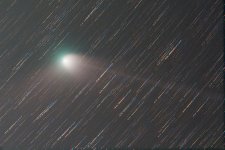
Using a MONO camera to image the Comet (C/2022 E3) is not the easiest thing to do. Previously I was able to make a "pretty picture" but not so this time around. The telescope mount tracks on the comet using data from NASA (Horizons project). The colored streaks occur because images are taken in R-G-B ... R-G-B sequence. 53 individual images were combined (Tracked on the Comet) to make this image. Normally the stars could be subtracted (edited out) and re-added later to make the "pretty picture". Not so this time.

- Messages
- 18,277
- Reaction score
- 11,006
- Points
- 288
How to see rare comet C/2022 E3 (ZTF) pass by Earth for first time in 50,000 years
- Published: Jan. 30, 2023, 1:39 p.m.
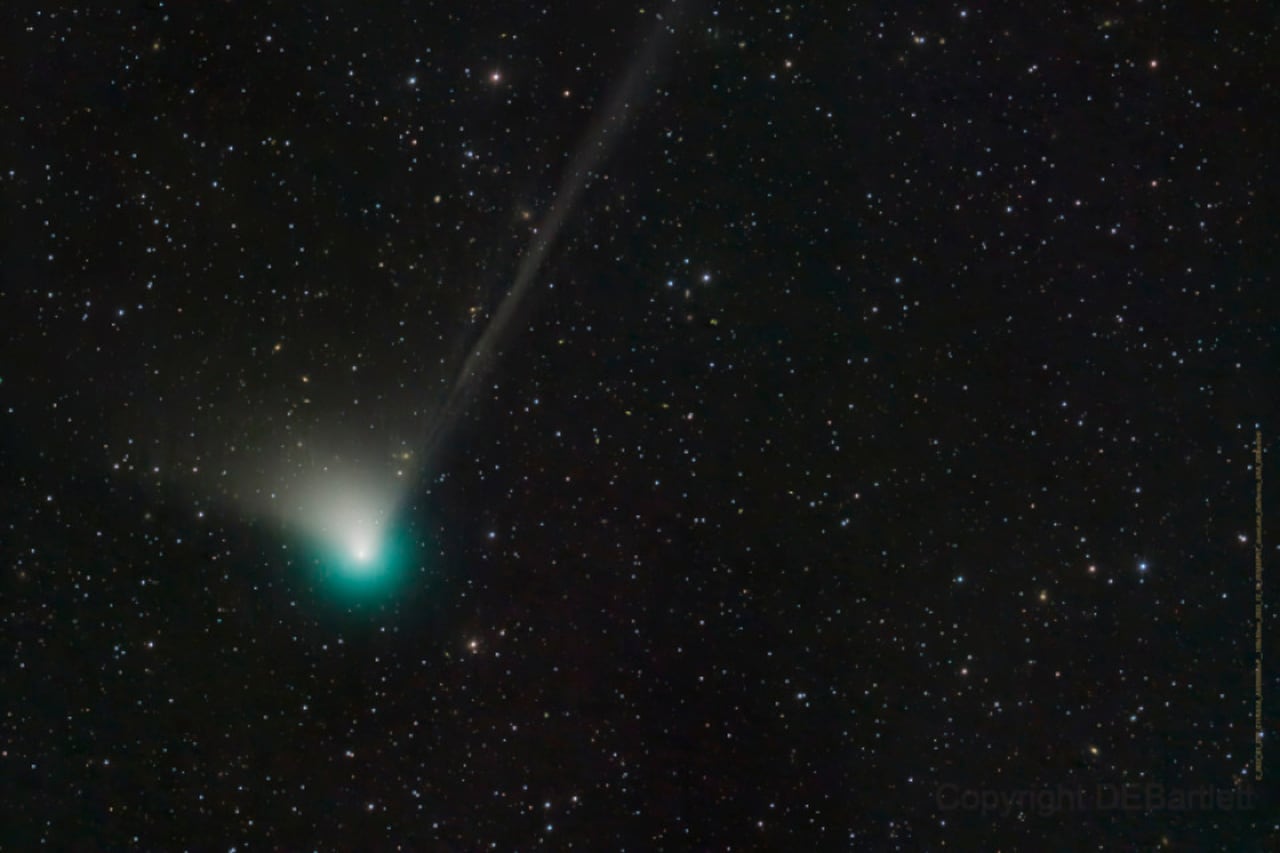
This photo provided by Dan Bartlett shows comet C/2022 E3 (ZTF) on Dec. 19, 2022. It last visited during Neanderthal times, according to NASA. It is expected to come within 26 million miles (42 million kilometers) of Earth on Feb. 1, 2023, before speeding away again, unlikely to return for millions of years. (Dan Bartlett via AP)AP
A glowing green comet that may only be visible from Earth every 50,000 years will make its closest approach to our planet this week.
Between Wednesday and Thursday, the comet will pass within about 26 million miles of Earth — about a quarter of the distance between us and the sun. In areas that are dark enough, it may be visible to the naked eye on those nights, NASA said.
The comet’s name — C/2022 E3 (ZTF) — is a bit of a mouthful, the space agency acknowledged earlier this month. But the journey it has taken through space is remarkable.
more
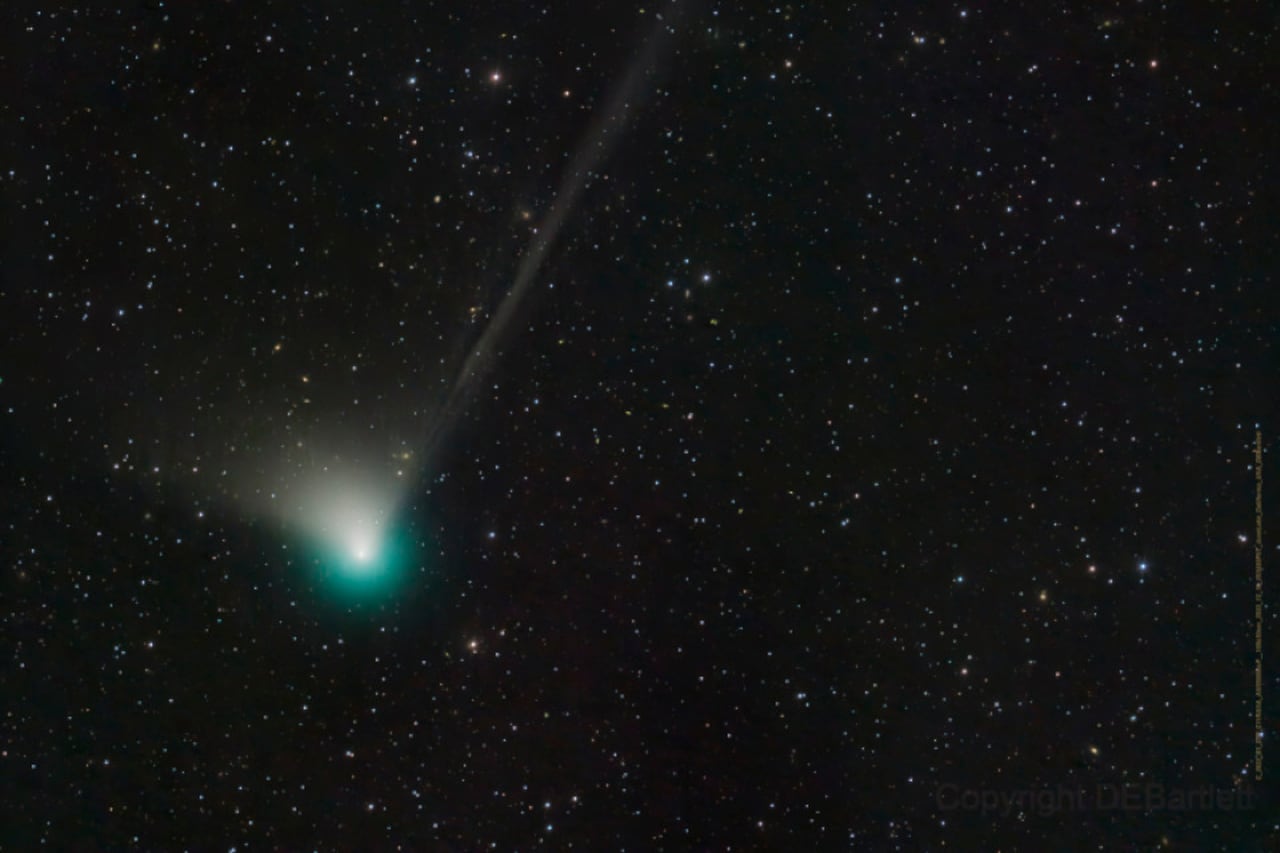
Look up Wednesday night - how to see rare comet without a telescope
Want to see something only our Neanderthal ancestors have seen before? Look up Wednesday and prepare to be amazed - assuming there aren't any clouds.
I am imaging Comet C/2022 E3 (ZTF) with Mars in the frame right now.
While I was doing my first preview exposures a group of starlink satellites crossed the comet. More pics to come hopefully once I get them processed.
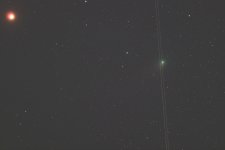
Date: 2/11/2023
Camera: Canon Rebel T8i(modified)
Telescope: 92mm f/5.5 triplet (Astrotech AT92) with focal reducer
Exposure: Single 60sec exposure at ISO 1600
While I was doing my first preview exposures a group of starlink satellites crossed the comet. More pics to come hopefully once I get them processed.

Date: 2/11/2023
Camera: Canon Rebel T8i(modified)
Telescope: 92mm f/5.5 triplet (Astrotech AT92) with focal reducer
Exposure: Single 60sec exposure at ISO 1600
Beautiful, especially for just 60 seconds.
Now and then I look at hyperstar capable scopes. The concept scares me a bit just seems like there is so much that can go wrong for a wide view. Looks like you pulled it off just fine though.
Now and then I look at hyperstar capable scopes. The concept scares me a bit just seems like there is so much that can go wrong for a wide view. Looks like you pulled it off just fine though.
Simply flabbergasting!!!!Single 60 second image on M42 with C14 Hyperstar.View attachment 6758
Hardest part was processing OCS for the first time (in years).
EdgeHD14(hyperstar V4)+ASI2600MC
No calibration frames.
- Messages
- 505
- Reaction score
- 743
- Points
- 268
The C14 was bought used from John Hayes. It has a good pedigree and I'm sure John tuned the corrector plate properly. I haven't had to adjust the tilt of the Hyperstar.Beautiful, especially for just 60 seconds.
Now and then I look at hyperstar capable scopes. The concept scares me a bit just seems like there is so much that can go wrong for a wide view. Looks like you pulled it off just fine though.
It is a delicate setup. I would not consider using it outside of an observatory. If I bunked into the camera/hyperstar appendage the corrector plate could break.
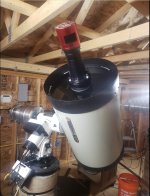
All the best!!
Steve
It's a monster! Beautiful piece of equipment. Do you plan to keep it in hyperstar mode or do you think you will do other stuff like planetary imaging with it?The C14 was bought used from John Hayes. It has a good pedigree and I'm sure John tuned the corrector plate properly. I haven't had to adjust the tilt of the Hyperstar.
It is a delicate setup. I would not consider using it outside of an observatory. If I bunked into the camera/hyperstar appendage the corrector plate could break.
View attachment 6760
All the best!!
Steve
That darn atmosphere getting in the way but I won't hold my breath for good seeing.
Was lucky just to finally get some clear skies here. I thought I was going to miss out on this comet. Now I get to do comet processing which is often quite a challenge. I think I got some good data.
Was lucky just to finally get some clear skies here. I thought I was going to miss out on this comet. Now I get to do comet processing which is often quite a challenge. I think I got some good data.
My mind is blown you were able to get that much detail on these galaxies in 20 minutes. Amazing what a focal ratio of f/2 can pull in with a cooled camera.20 Minutes on M81 & M82 with C14 Hyperstar.View attachment 6774
Very nice work.
Just went through the process of successfully stacking in PixInsight for the first time. Normally I have done my stacking in DSS and previously had trouble with PixInsight not applying calibrations properly for some reason. Worked through that and managed to register the stars and comet separately and then re-combined.
I expect to improve on this. Hoping I can get the ion tail to stand out more without making some streaky artifacts more visible. I don't mind and expected that Mars looks kind of funky.
Comet C/2022 E3 (ZTF) with Mars
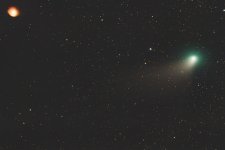
I expect to improve on this. Hoping I can get the ion tail to stand out more without making some streaky artifacts more visible. I don't mind and expected that Mars looks kind of funky.
Comet C/2022 E3 (ZTF) with Mars

Just went through the process of successfully stacking in PixInsight for the first time. Normally I have done my stacking in DSS and previously had trouble with PixInsight not applying calibrations properly for some reason. Worked through that and managed to register the stars and comet separately and then re-combined.
I expect to improve on this. Hoping I can get the ion tail to stand out more without making some streaky artifacts more visible. I don't mind and expected that Mars looks kind of funky.
Comet C/2022 E3 (ZTF) with Mars
View attachment 6790
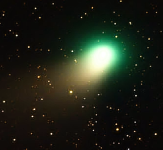
- Messages
- 505
- Reaction score
- 743
- Points
- 268
Intrigued by someone else's image of the Helix Galaxy, I had to give it a try. Three hours of RGB data, in 600 second subs. It is tiny and a challenge to capture.
From Wikipedia - NGC 2685 (also known as the Helix Galaxy) is a lenticular and polar ring Seyfert Type 2 galaxy in the constellation Ursa Major. It is about 50,000 light-years across and about 42 million light-years away from Earth. It is receding from Earth at 883 kilometers per second. It is an object of great scientific interest, because polar-ring galaxies are very rare galaxies. They are thought to form when two galaxies gravitationally interact with each other. "The bizarre configuration could be caused by the chance capture of material from another galaxy by a disk galaxy, with the captured debris strung out in a rotating ring. Still, observed properties of NGC 2685 suggest that the rotating ring structure is remarkably old and stable.
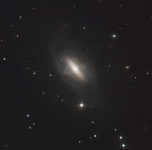
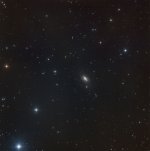
From Wikipedia - NGC 2685 (also known as the Helix Galaxy) is a lenticular and polar ring Seyfert Type 2 galaxy in the constellation Ursa Major. It is about 50,000 light-years across and about 42 million light-years away from Earth. It is receding from Earth at 883 kilometers per second. It is an object of great scientific interest, because polar-ring galaxies are very rare galaxies. They are thought to form when two galaxies gravitationally interact with each other. "The bizarre configuration could be caused by the chance capture of material from another galaxy by a disk galaxy, with the captured debris strung out in a rotating ring. Still, observed properties of NGC 2685 suggest that the rotating ring structure is remarkably old and stable.


Intrigued by someone else's image of the Helix Galaxy, I had to give it a try. Three hours of RGB data, in 600 second subs. It is tiny and a challenge to capture.
From Wikipedia - NGC 2685 (also known as the Helix Galaxy) is a lenticular and polar ring Seyfert Type 2 galaxy in the constellation Ursa Major. It is about 50,000 light-years across and about 42 million light-years away from Earth. It is receding from Earth at 883 kilometers per second. It is an object of great scientific interest, because polar-ring galaxies are very rare galaxies. They are thought to form when two galaxies gravitationally interact with each other. "The bizarre configuration could be caused by the chance capture of material from another galaxy by a disk galaxy, with the captured debris strung out in a rotating ring. Still, observed properties of NGC 2685 suggest that the rotating ring structure is remarkably old and stable.
Fascinating. Also I really like all the tiny galaxies in the background.
- Messages
- 1,620
- Reaction score
- 2,271
- Points
- 298
Suppose that is a spaceship 50,000 light years long...Intrigued by someone else's image of the Helix Galaxy, I had to give it a try. Three hours of RGB data, in 600 second subs. It is tiny and a challenge to capture.
From Wikipedia - NGC 2685 (also known as the Helix Galaxy) is a lenticular and polar ring Seyfert Type 2 galaxy in the constellation Ursa Major. It is about 50,000 light-years across and about 42 million light-years away from Earth. It is receding from Earth at 883 kilometers per second. It is an object of great scientific interest, because polar-ring galaxies are very rare galaxies. They are thought to form when two galaxies gravitationally interact with each other. "The bizarre configuration could be caused by the chance capture of material from another galaxy by a disk galaxy, with the captured debris strung out in a rotating ring. Still, observed properties of NGC 2685 suggest that the rotating ring structure is remarkably old and stable.
View attachment 6862
View attachment 6863
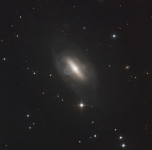
No wonder we haven't been contacted.
A couple from a 2 weeks ago I finally got around to processing.
M44 (The Beehive Cluster) - Open cluster in Cancer
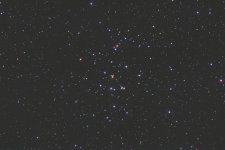
Date: 2/25/2023
Camera: Canon Rebel T8i
Telescope: 92mm f/5.5 triplet (Astrotech AT92) with focal reducer
Exposure: 41x120sec (1hr 22min total) at ISO 400
M51 (The Whirlpool Galaxy) - Spiral Galaxy in Canes Venatici, a very wide view
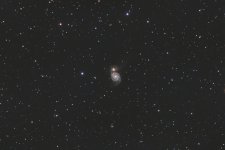
Date: 2/25/2023
Camera: Canon Rebel T8i
Telescope: 92mm f/5.5 triplet (Astrotech AT92) with focal reducer
Exposure: 90x180sec (4hr 30min total) at ISO 400
M44 (The Beehive Cluster) - Open cluster in Cancer

Date: 2/25/2023
Camera: Canon Rebel T8i
Telescope: 92mm f/5.5 triplet (Astrotech AT92) with focal reducer
Exposure: 41x120sec (1hr 22min total) at ISO 400
M51 (The Whirlpool Galaxy) - Spiral Galaxy in Canes Venatici, a very wide view

Date: 2/25/2023
Camera: Canon Rebel T8i
Telescope: 92mm f/5.5 triplet (Astrotech AT92) with focal reducer
Exposure: 90x180sec (4hr 30min total) at ISO 400
Tiangong (the Chinese space station) trail with Orion last night
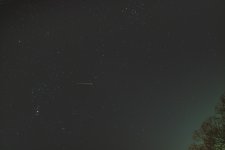
Date: 3/14/2023
Camera: Canon Rebel T8i
Lens: 28mm f/1.4 Sigma
Exposure: 5sec at ISO 800 and f/1.4
Processed using PixInsight
PixInsight notes: ABE, Background Neutralization, ColorCalibration, NoiseXterminator, ArcsinhStretch, CurvesTransformation to slightly increase contrast and saturation

Date: 3/14/2023
Camera: Canon Rebel T8i
Lens: 28mm f/1.4 Sigma
Exposure: 5sec at ISO 800 and f/1.4
Processed using PixInsight
PixInsight notes: ABE, Background Neutralization, ColorCalibration, NoiseXterminator, ArcsinhStretch, CurvesTransformation to slightly increase contrast and saturation
Thanks! It was a random oportunity while I was out taking test exposures to see if there was any aurora. I'm digging that lens. Would be fun to have it under a truly dark sky.

